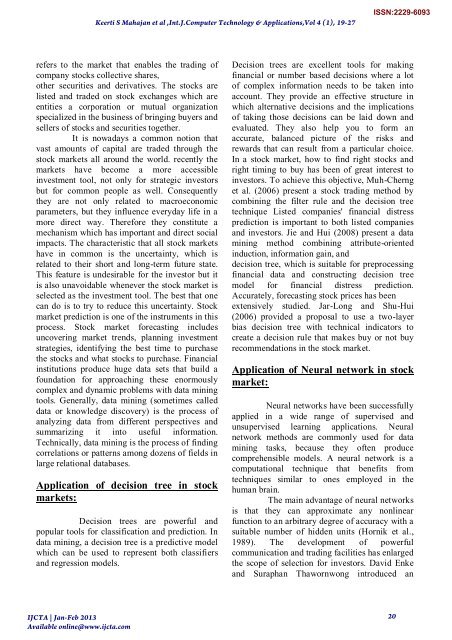application of datamining tools for stock market - International ...
application of datamining tools for stock market - International ...
application of datamining tools for stock market - International ...
You also want an ePaper? Increase the reach of your titles
YUMPU automatically turns print PDFs into web optimized ePapers that Google loves.
Keerti S Mahajan et al ,Int.J.Computer Technology & Applications,Vol 4 (1), 19-27<br />
ISSN:2229-6093<br />
refers to the <strong>market</strong> that enables the trading <strong>of</strong><br />
company <strong>stock</strong>s collective shares,<br />
other securities and derivatives. The <strong>stock</strong>s are<br />
listed and traded on <strong>stock</strong> exchanges which are<br />
entities a corporation or mutual organization<br />
specialized in the business <strong>of</strong> bringing buyers and<br />
sellers <strong>of</strong> <strong>stock</strong>s and securities together.<br />
It is nowadays a common notion that<br />
vast amounts <strong>of</strong> capital are traded through the<br />
<strong>stock</strong> <strong>market</strong>s all around the world. recently the<br />
<strong>market</strong>s have become a more accessible<br />
investment tool, not only <strong>for</strong> strategic investors<br />
but <strong>for</strong> common people as well. Consequently<br />
they are not only related to macroeconomic<br />
parameters, but they influence everyday life in a<br />
more direct way. There<strong>for</strong>e they constitute a<br />
mechanism which has important and direct social<br />
impacts. The characteristic that all <strong>stock</strong> <strong>market</strong>s<br />
have in common is the uncertainty, which is<br />
related to their short and long-term future state.<br />
This feature is undesirable <strong>for</strong> the investor but it<br />
is also unavoidable whenever the <strong>stock</strong> <strong>market</strong> is<br />
selected as the investment tool. The best that one<br />
can do is to try to reduce this uncertainty. Stock<br />
<strong>market</strong> prediction is one <strong>of</strong> the instruments in this<br />
process. Stock <strong>market</strong> <strong>for</strong>ecasting includes<br />
uncovering <strong>market</strong> trends, planning investment<br />
strategies, identifying the best time to purchase<br />
the <strong>stock</strong>s and what <strong>stock</strong>s to purchase. Financial<br />
institutions produce huge data sets that build a<br />
foundation <strong>for</strong> approaching these enormously<br />
complex and dynamic problems with data mining<br />
<strong>tools</strong>. Generally, data mining (sometimes called<br />
data or knowledge discovery) is the process <strong>of</strong><br />
analyzing data from different perspectives and<br />
summarizing it into useful in<strong>for</strong>mation.<br />
Technically, data mining is the process <strong>of</strong> finding<br />
correlations or patterns among dozens <strong>of</strong> fields in<br />
large relational databases.<br />
Application <strong>of</strong> decision tree in <strong>stock</strong><br />
<strong>market</strong>s:<br />
Decision trees are powerful and<br />
popular <strong>tools</strong> <strong>for</strong> classification and prediction. In<br />
data mining, a decision tree is a predictive model<br />
which can be used to represent both classifiers<br />
and regression models.<br />
Decision trees are excellent <strong>tools</strong> <strong>for</strong> making<br />
financial or number based decisions where a lot<br />
<strong>of</strong> complex in<strong>for</strong>mation needs to be taken into<br />
account. They provide an effective structure in<br />
which alternative decisions and the implications<br />
<strong>of</strong> taking those decisions can be laid down and<br />
evaluated. They also help you to <strong>for</strong>m an<br />
accurate, balanced picture <strong>of</strong> the risks and<br />
rewards that can result from a particular choice.<br />
In a <strong>stock</strong> <strong>market</strong>, how to find right <strong>stock</strong>s and<br />
right timing to buy has been <strong>of</strong> great interest to<br />
investors. To achieve this objective, Muh-Cherng<br />
et al. (2006) present a <strong>stock</strong> trading method by<br />
combining the filter rule and the decision tree<br />
technique Listed companies' financial distress<br />
prediction is important to both listed companies<br />
and investors. Jie and Hui (2008) present a data<br />
mining method combining attribute-oriented<br />
induction, in<strong>for</strong>mation gain, and<br />
decision tree, which is suitable <strong>for</strong> preprocessing<br />
financial data and constructing decision tree<br />
model <strong>for</strong> financial distress prediction.<br />
Accurately, <strong>for</strong>ecasting <strong>stock</strong> prices has been<br />
extensively studied. Jar-Long and Shu-Hui<br />
(2006) provided a proposal to use a two-layer<br />
bias decision tree with technical indicators to<br />
create a decision rule that makes buy or not buy<br />
recommendations in the <strong>stock</strong> <strong>market</strong>.<br />
Application <strong>of</strong> Neural network in <strong>stock</strong><br />
<strong>market</strong>:<br />
Neural networks have been successfully<br />
applied in a wide range <strong>of</strong> supervised and<br />
unsupervised learning <strong>application</strong>s. Neural<br />
network methods are commonly used <strong>for</strong> data<br />
mining tasks, because they <strong>of</strong>ten produce<br />
comprehensible models. A neural network is a<br />
computational technique that benefits from<br />
techniques similar to ones employed in the<br />
human brain.<br />
The main advantage <strong>of</strong> neural networks<br />
is that they can approximate any nonlinear<br />
function to an arbitrary degree <strong>of</strong> accuracy with a<br />
suitable number <strong>of</strong> hidden units (Hornik et al.,<br />
1989). The development <strong>of</strong> powerful<br />
communication and trading facilities has enlarged<br />
the scope <strong>of</strong> selection <strong>for</strong> investors. David Enke<br />
and Suraphan Thawornwong introduced an<br />
IJCTA | Jan-Feb 2013<br />
Available online@www.ijcta.com<br />
20















